The rain had stopped when we woke this morning. It was not to last but, being unaware of this, we faced the day with renewed optimism. It was gone lunch time before we were ready to move on from Pécs. Our ultimate destination is Debrecen to visit István and Ibolya. We first met István in Exeter when he spent a year at the Postgraduate Medical School and was a regular user of the Medical Library. He was later joined in Exeter by his wife Ibolya and we all became friends. Although we have not met since, we have stayed in touch and have always threatened that we would visit them in their home town once we retired. They have put a brave face on it and are expecting us later this week.
In the meantime we are making our leisurely way across Hungary with time to explore as we go. We drove towards Mohács, stopping at a roadside vendegló for lunch. A vendegló is similar to a csárda, a restaurant serving very nice traditional food, frequently with gipsy music accompaniment. No music today but a very pleasant three course lunch of liver dumplings in soup, chicken with chips and pickled cabbage followed by apple retes with cloves and cinnamon for around £4 each.
The roads were almost deserted as we crossed Hungary, an essentially rural country with fields of wheat and vineyards as far as the eye could see. Along straight tree-lined roads we passed several carts, each pulled by a couple of horses. In the villages we frequently saw older ladies wearing head scarves, aprons and trousers sweeping or hoeing outside their houses.
 Modestine overtakes the local traffic, Hungary
Modestine overtakes the local traffic, HungaryWe stopped briefly at Nagynarad, a village settled by German immigrants after the departure of the Turks. The wide streets were lined with trees and many of the houses were elaborately decorated with stucco. The large baroque church was apparently built with the support of the Empress Maria Theresa in the 1750s. The Germans introduced the craft of indigo dying and it is still continued there. On an earlier visit Ian had seen the workshop and had purchased examples of the work, but it was closed today.
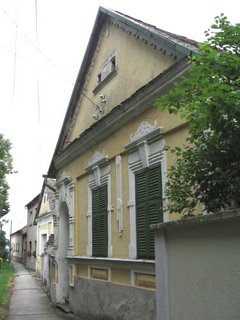 Stucco houses in Nagynarad, Hungary
Stucco houses in Nagynarad, Hungary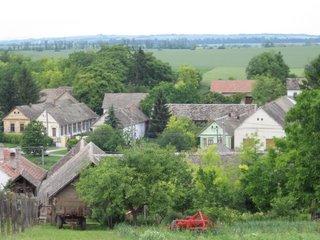 Farm houses in Nagynarad, Hungary
Farm houses in Nagynarad, Hungary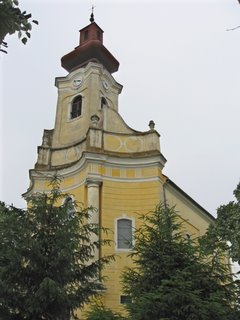 The baroque church in Nagynarad, Hungary
The baroque church in Nagynarad, HungarySoon we reached the memorial on the outskirts of the town of Mohács. This was set up in 1976 as a memorial to the defeat of the Hungarian army in the battle against the Turks on 29th August 1526. This is a date that is as indelibly etched on the historical memories of Hungarians as the Battle of Hastings is for the British. The army of the Hungarian King Ludwig II and his mercenaries attacked the Turks before his allies arrived and were soundly beaten. The King himself was killed while fleeing the battle. The defeat signalled the end of the independent medieval Hungarian kingdom and ushered in a century and a half of domination by the Turks. In the mid 20th century mass graves of those killed in the battle were discovered and excavated and the memorial set up over their remains. It consists of over 100 carved wooden poles, which give a wild and primitive impression, rather like totem poles, and echo carved wooden memorials to be found in many parts of central Europe. Leading up to it is a brutalist concrete 1970s socialist memorial complex and an extensive display, almost entirely in Hungarian, on the lead-up to the battle and its aftermath. Probably for our benefit, an English account of the significance of the memorial was relayed over a loudspeaker, although whether it was appreciated by the group of Islamic women who were visiting we could not tell.
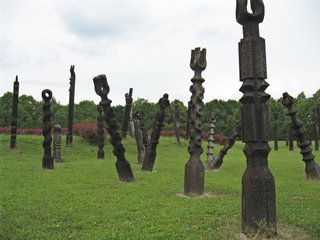 Wooden sculptures at the memorial to the battle of Mohács, Hungary
Wooden sculptures at the memorial to the battle of Mohács, Hungary Wooden sculptures of a soldier and horses at the memorial to the battle of Mohács, Hungary
Wooden sculptures of a soldier and horses at the memorial to the battle of Mohács, Hungary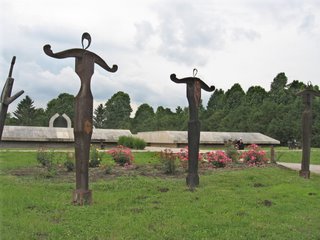 Wooden sculptures and concrete entrance at the memorial to the battle of Mohács, Hungary
Wooden sculptures and concrete entrance at the memorial to the battle of Mohács, HungaryBy now the weather had changed and the rain was falling steadily. The road surface, poor at the best of times, was awash with water, the many potholes filled to the brim and overflowing. There was no possibility of exploring further and our attention was so concentrated on finding a campsite for the evening that we failed to realise until later that we were passing within a few kilometres of Croatia. Jill was really disappointed when she realised as we could so easily have included it on our itinerary but it is too late to turn back now.
Eventually we reached Kiskunhalas, about midway between Pecs and Debrecen and found a sign indicating a campsite which we followed across town. It was still raining heavily when we arrived and the person on duty spoke nothing but Hungarian. So we are now in a waterlogged field with no idea of where we are or what lies beyond the shower block. Just getting there is an adventure requiring the removal of shoes and socks to cross the lake of oozing mud and saturated grass in the dark. We cannot believe the sky can hold so much water! We have been in Hungary a full week now but have enjoyed a total of less than 48 hours without heavy rain. Fortitude is wearing thin!
Monday 5th June 2006, Debrecen, Hungary
This morning the wind was blowing strongly but during the night it had chased away the rain so there was even some sunshine although it was too chilly and muddy to be outside. The campsite had dried out considerably leaving it a sticky mess of mud and water-filled potholes. Everyone on the site was German and that was the language in use around the site. The Brits flock to the sun in the South of Spain. The Germans come to Hungary in their thousands and appear to spend their time sitting around the campsite all day with beers chatting to their neighbours. The attraction, we have now discovered, is the thermal spars to which most of the campsites in Hungary are attached. Apparently the costs for using the thermal baths and of any treatment – massage, sauna etc, are generally paid by the German health insurance, the curist paying only for accommodation.
When we went to pay today our bill was really quite expensive. When we questioned it we were told – in very halting German - that it included a day ticket to the thermal spa. We explained we'd arrived at 7.30 last night in torrential rain and the spa wasn't even open, but we were told that was the arrangement. As this was not made clear to us last night and they'd simply told us to sort ourselves out in the mud and pay today Jill was very angry about it. However, they had Ian's passport and we were not getting it back until we paid double the camping prices listed outside the site in Hungarian alone. We didn't even know there was a spa there until we were given the bill! Another time a warm swim would have been wonderful but we were packed to leave and the weather wasn't at all nice for a swim anyway and we are not sick, in need of a cure, or likely to be reclaiming our costs from the NHS.
So the day started badly with Jill very angry, not so much at the cost, but at the sense that we had been cheated but did not have sufficient communication skills to argue our case. All this put a damper on the day and our enthusiasm to turn south for a brief visit into Yugoslavia evaporated. So not only have we missed Croatia, but Yugoslavia as well. We are unlikely to be driving this distance again so that's two missed opportunities.
However, the day improved with a bit of excitement when we were stopped by the police as we travelled north along a quiet route leading from the Yugoslav border. They pulled us over and looked at our passports very carefully before walking all around Modestine and peering inside the back door. Maybe we looked like people smugglers and they thought our two lumpy bags with Hinge and Bracket inside actually concealed East European Immigrants!
Seriously though, the annoying habit of campsite managers hanging on to passports until you pay and leave could land us in trouble. They are rarely willing to let us pay up front and keep our passports. We've had several arguments about it, not just in Hungary but also in Italy and Spain. They all claim they need it for the police. We've pointed out that we do too and offered them photocopies. Sometimes it works. Fortunately we were between camps and had all our documents today.
We stopped for lunch, fuel and to refill our purse at Kiskunfélegyháza, a very pleasant, quiet little town with an attractive town hall faced in tiles from the old Zsolnay factory in Pécs. There is a pleasant park with a yellow rendered church and the public library. Today is a national holiday in Hungary so most buildings were closed. Along the tree lined road we found a very pleasant cake shop with little tables and stopped for coffee, a couple of savoury scones and what we expected to be savoury cream cheese rolls. However, Ian's Hungarian had only been half understood and we ended up with cherry cheesecake instead. "Nem baj" (never mind) as the Hungarians say. Everything was delicious and the total bill was 700 forints – less than £2!
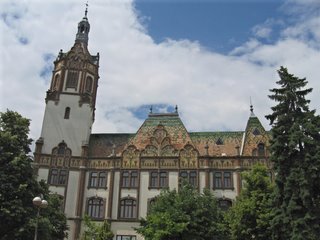 Town hall at Kiskunfélegyháza, Hungary
Town hall at Kiskunfélegyháza, Hungary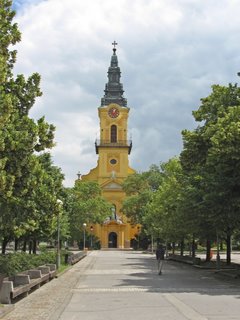 The church at Kiskunfélegyháza, Hungary
The church at Kiskunfélegyháza, HungaryOn the map many roads run right up to the eastern and southern borders and simply stop! Within Hungary we have found most of the roads, particularly around here, very few and very empty. We have been able to travel peacefully across Eastern Hungary during the course of the day. The landscape stretches flat for ever and reminds us rather of Holland. The roads often form dykes with drainage ditches to either side. In the Hortobágy region in particular there is an enormous quantity of water with rivers, streams and waterlogged fields. When we stopped to take some photos the air was vibrating with the sound of thousands of bull frogs. (We've noticed that paprika frogs legs have appeared on at least one restaurant menu). We have seen isolated thatched farm buildings standing amidst tall reed beds, storks nesting on any available raised area - usually a telephone pole or the roof of a house in one of the isolated villages. We have seen wells and shadoufs for raising water for the herds of animals said to roam here. The Hortobágy region lies towards the east of the country and is far more remote and empty than further west. It is supposed to be the area of long-horned cattle and wild horses. We have seen neither.
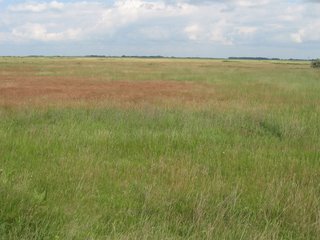 Typical landscape in the Hortobágy region, Hungary
Typical landscape in the Hortobágy region, Hungary Farm in the Hortobágy region, Hungary
Farm in the Hortobágy region, Hungary Isolated building with wooden shadouf to the right, Hortobágy region, Hungary
Isolated building with wooden shadouf to the right, Hortobágy region, HungaryWe passed huge plantations of poppies looking very pretty and grown as a commercial crop. Here poppy seed is used extensively in cooking, one type of cake we have tasted is just filled with sticky sweet poppy seeds. We have seen very little in the way of livestock although passing through villages in particularly remote areas we have seen chickens and turkeys in people's gardens alongside the wonderfully tidy vegetable plots.
 Poppies grown commercially, Hungary
Poppies grown commercially, HungaryOut in the open countryside the roads are in a dreadful state as they run across the flat landscape with arable crops and vegetables in huge collective fields without hedges, broken only occasionally by rivers, railways or drainage ditches. There are extensive skyscapes of billowing clouds which can be very beautiful on the open plains. Today we followed these broken, deserted roads for a good hundred kilometres, weaving our way around the water-filled potholes and cracked and crumbling tarmac, driving as often on the left as on the right trying to avoid a broken axle.
 Fields and sky in the Hortobágy, Hungary
Fields and sky in the Hortobágy, Hungary Roadside view the Hortobágy region, Hungary
Roadside view the Hortobágy region, HungaryHaving crossed the Hortobágy plains by these routes, we eventually picked up the main route from Budapest to Debrecen and made far better progress but with little of interest to delay us.
Debrecen has a population of over 220,000 and we had only a national road map. We knew István and Ibolya lives to the north and we found a campsite marked in that general area on our map. It took a good many wrong turnings before we homed in on the area and discovered yet another thermal bath! No campsite however. In despair we entered the hotel beside the baths and asked for a street plan. Assuming we were guests they gave us one without question and we located the campsite. On arriving we discovered it closed down and abandoned. It would have been within easy walking distance of István's house. The only other campsite was right back across the other side of town but at least we now had a map. Arriving there we discovered it too was closed up and abandoned. Both are listed on at least three current town maps and guides with addresses and phone numbers so Hungarian maps appear to be very unreliable.
It was now getting late and the prospect of sleeping by the roadside was becoming a real probability. A few kilometres south was a site we'd discovered in a recent internet search, just off the map. On our way through the countryside south of the town we came across a site by chance and turned in with relief. Our luck was out though as it was so awful we asked for our money back. Old rusty plumbing, graffiti strewn walls, a boiler that looked singularly unsafe, showers without spray heads and the water running red with rust when we turned on the tap. However, the site did have one of the few remaining statues of Lenin that had somehow escaped being smashed up. Presumably it had been removed from the city centre at some stage to stand in an isolated corner of a deserted and unlisted campsite. Beside it lay the broken bronze torso of some other long forgotten Soviet hero.
 Lenin blesses Modestine, Debrecen
Lenin blesses Modestine, DebrecenFurther on we found the site we were seeking. It was open and seems reasonable though not as clean as we could have wished and too far out from the city. We rang István to tell him we were in Debrecen and have arranged to go to his house tomorrow afternoon after he finishes work at the hospital.
Tuesday 6th June 2006, Debrecen, Hungary
One of the enjoyable things about this nomadic lifestyle we are living is that so often the end of the day turns out to be completely different from our expectations at the start. This is very much the case today.
The campsite we found yesterday really was too far out of the city to be practical. After leaving Modestine on the site we waited by a wooded roadside for a good hour for a bus that never turned up. Returning to the campsite we packed everything away, disconnected the electricity and paid our bill. This turned out to be the usual shock where it was considerably more than anticipated because of a tourist tax we had to pay. Noticing that pensioners received a large reduction we pointed out that we were retired. Asked our age we were told we did not qualify as we were under 70, the normal retirement age in Hungary! (We have since checked with István who says this is not currently the case but may be in the future).
So we drove in to Debrecen and parked Modestine on the forecourt of the swanky hotel that had given us a map yesterday on the assumption they would continue to think we were guests and she would be safer there than parked in a side street of the town.
Walking back across the park and down the main, tree-lined street towards the town centre we stopped at a couple of very pleasant guest houses to enquire about the cost of rooms. Generally they were around £28 - £34 for a double room with breakfast. Given the inconvenience of the camp-site and the fact that we have lately been paying higher camp site prices here than we have generally done in other countries, we thought we'd probably stay in a guesthouse near István's home for tonight. First though, we'd see what plans he may have made for us. It was as well we did. At the internet shop in town we found an email from him saying we could stay either with them or use the guest room at the University Department of Paediatrics!
We have had little time to look at the town today so we will leave our description of the city until later. Our first impression though is that it is rather unusual as the streets leading off the main roads are immediately like country villages with tree-lined roads and attractive classical-style buildings. The arterial routes through the city however are filled with lorries, buses, trolley-buses and trams. As a pedestrian it takes ages to get anywhere as the only possibility of crossing roads is at traffic lights and you can wait several minutes for the lights to allow it. Nobody in Hungary dreams of crossing until the green man says it's okay, even if there is no traffic around!
For lunch we found somewhere pleasant for coffees and a pizza with Hungarian topping – red onions, paprika sausage, tomatoes and melted cheese. Wise to the size of Hungarian meals and knowing we would be spoilt by Ibolya later we asked for one to share. It was still plentiful.
We found a Marks and Spencer which we peeped in at. It looks just like the one in Exeter though on a smaller scale. Apparently there is also a Sainsbury and a Tesco hypermarket here. Looking for a little present for our hosts we bought a box of biscuits that looked very English but turned out to be Danish. The lady in the shop gave us each a chocolate-coated marshmallow lamb on a kebab stick as a present!
It was time to find István and Ibolya at their home up near the park. They came to the gate to greet us and ten years just disappeared as we all hugged each other. Soon we were sitting in the lounge of their flat with poor István working overtime translating everything for all of us. Unfortunately Ibolya speaks no English or German but we find we still manage to understand each other pretty well.
Having caught up on general family news on both sides István suggested we check out Modestine and visit the medical campus and University clinics. As Modestine seemed very happy we left her where she was and took a stroll around the University Faculty of Medicine, much of which has been rebuilt in recent years so is modern and bright providing residential accommodation for overseas doctors studying here. We were shown István's office and the newly built children's clinics. We also visited the lecture theatre where as a part of his duties as Professor of Paediatric Medicine at the University Hospital he lectures on paediatric endocrinology and childhood diabetes. In addition István is also responsible for co-ordinating the continuing medical education of general practitioners.
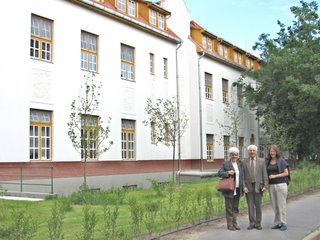 Ibolya, István and Jill outside the new Paediatric clinics, University of Debrecen
Ibolya, István and Jill outside the new Paediatric clinics, University of Debrecen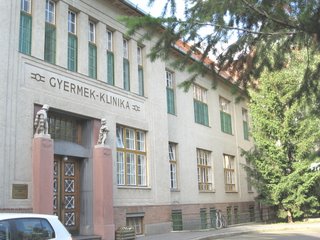 Centre for Paediatrics, University of Debrecen
Centre for Paediatrics, University of Debrecen Lecture theatre, Medical campus, University of Debrecen
Lecture theatre, Medical campus, University of DebrecenThen, as a point of interest for Jill he showed us into the specialist library of the Department of Paediatrics. It was a case of "déjà-vu"! Almost every title was very familiar with back issues neatly bound and arranged on the shelves. Help, get me out of here. I've left all this behind!
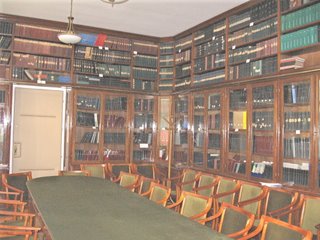 Library for the department of Paediatrics, University of Debrecen
Library for the department of Paediatrics, University of DebrecenIn another recent building across the campus we were shown into the Department of General Practice where there is a guest room for visiting lecturers. We are now presumably registered with the University of Debrecen as specialist clinicians from Britain on a study visit to observe Hungarian methods of continuing medical education!
Next we returned for a lovely Hungarian supper of meat goulash with potatoes prepared by Ibolya. The evening was delightful and we were given a couple of beautifully illustrated books about Hungary in general and Debrecen in particular. We feel overwhelmed by the warmth of our reception when both István and Ibolya lead busy working lives and they are at work by 7am!
Because of this we left quite early. They guided us back to the medical campus and after giving us a swipe card to get into the building they have disarmed the alarm system leading to our room. We only hope they've done it correctly. It went off once as they did it and it's deafening. We'd have a job explaining to security staff what we were doing here if they came to investigate! The room is very nice with a television, a smart ensuite bathroom and a real bed! We've not slept in one of those for months now! The room seems hundreds of times larger than Modestine with space for Ian to leave his shoes wherever he likes! Modestine has now been moved and is standing in István's personal parking space outside the building. She mixes in illustrious circles does our Modestine! Soviet leaders one day and Professors of Paediatrics the next!
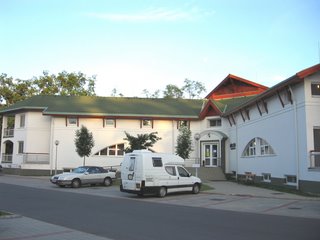 Modestine studies medicine, University of Debrecen
Modestine studies medicine, University of DebrecenWednesday 7th June 2006, Debrecen, Hungary
We took the rackety old tram down through the streets from the medical clinics to the centre of the town in bright sunshine this morning. It was not to last however and before the morning was out the rain was back. It has come and gone every hour or so throughout the day but we have managed to have a wonderful time none-the-less.
We spent the morning sightseeing the centre of the town which is dominated by a huge square surrounded by attractive stuccoed buildings on a grand scale. The area has recently been pedestrianised but the trams still grind their way noisily across. There are a couple of interesting fountains, one on each side and the coat of arms of the city is inset into the paving in front of the Protestant temple.
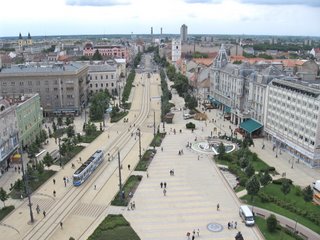 Kossuth tér, Debrecen
Kossuth tér, Debrecen Coat of Arms of Debrecen
Coat of Arms of Debrecen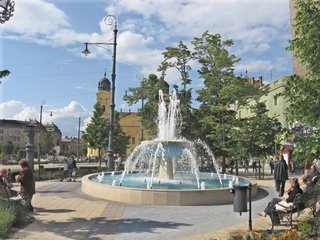 Fountain on Kossuth tér, Debrecen
Fountain on Kossuth tér, DebrecenDebrecen is known as the Protestant Rome, having opted for the reformed church of Calvin in 1540. There are consequently a couple of major Protestant temples and the Calvinist College with its valuable library of mainly religious works. Even when the Austrians freed the city from the Turks in the 1680s the inhabitants were not persuaded to return to the Catholic faith of the Habsburgs. The Great Reformed Church was really built, massively blocking the end of the main street, as an act of defiance in 1810. The city was also at the heart of the Hungarian independence movement in the 1840s. The chair from which Lajos Kossuth proclaimed independence from the Austrians in 1849 is venerated almost as a holy relic in the otherwise austere Great Reformed Church. The Small Reformed Church too had its moment of glory when the citizens met there to protest against the Habsburg attempt to place restrictions on the Protestant faith. An ambassador from Vienna arrived and declared "In the King's name I forbid this meeting". To this the local Bishop replied "In God's name I declare it open". The proposals were later withdrawn. Many of the public buildings reflect the severe Calvinist view of the world. There is little baroque fantasy and most of the public buildings are in a simple classical style. Beside the Reformed College these include the old Town Hall. The Secessionist movement, better known though as the Art Nouveau style, manifested itself in a number of remarkable buildings which line the main street - Piac utca or Market Street. These include the County Hall and one of the earliest bank buildings. Other striking buildings along the main axis include the Chamber of Commerce. There is relatively little off the main street except for the Csokonai Theatre and the Déri Museum.
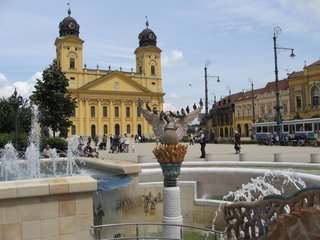 Grand Reformed Church (1803-23), Kossuth tér, Debrecen
Grand Reformed Church (1803-23), Kossuth tér, Debrecen Interior of the Grand Reformed Church with organ and pulpit, Kossuth tér, Debrecen
Interior of the Grand Reformed Church with organ and pulpit, Kossuth tér, Debrecen Chair of Lajos Kossuth in the Grand Reformed Church, Kossuth tér, Debrecen
Chair of Lajos Kossuth in the Grand Reformed Church, Kossuth tér, Debrecen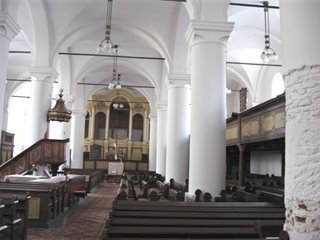 Interior of the Little Reformed Church (1720), Debrecen
Interior of the Little Reformed Church (1720), Debrecen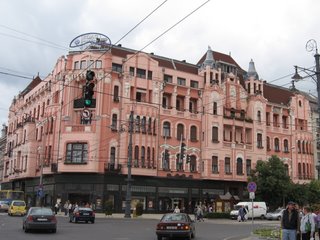 First savings bank in Art Nouveau style (1911-12), Debrecen
First savings bank in Art Nouveau style (1911-12), Debrecen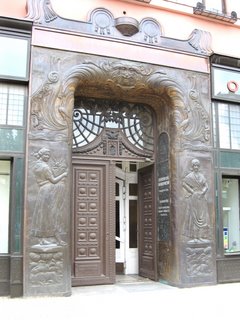 Doorway of savings bank, Debrecen
Doorway of savings bank, Debrecen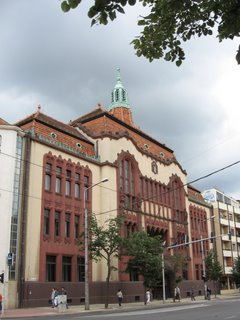 County Hall (1912), Debrecen
County Hall (1912), Debrecen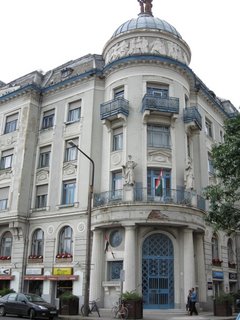 Chamber of Commerce (1910-11), Debrecen
Chamber of Commerce (1910-11), Debrecen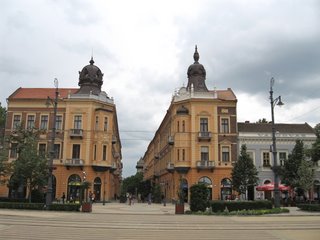 First council houses (1900-01), Debrecen
First council houses (1900-01), Debrecen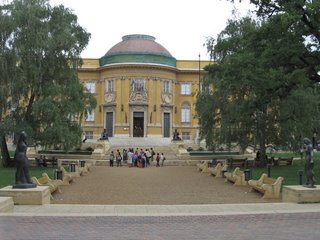 Deri Museum (1926-28), Debrecen
Deri Museum (1926-28), Debrecen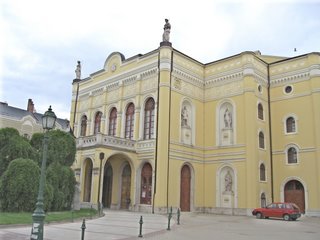 Csokonai Theatre (1861-65), Debrecen
Csokonai Theatre (1861-65), DebrecenWe climbed the tower in the Great Reformed Church which gave us a birds-eye view down onto the city and away to the far distance without a hill in sight! The area is totally flat with nothing but an occasional church spire to relieve it.
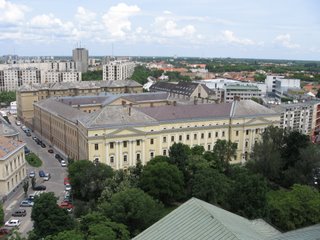 Reformed College from the tower, Debrecen
Reformed College from the tower, Debrecen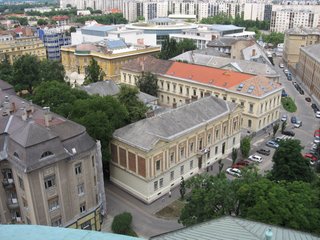 Debrecen with Communist housing blocks in the background
Debrecen with Communist housing blocks in the backgroundWe had an interesting lunch at a salad bar where we watched everyone else to find out how to order and then made good use of our pointing finger. We waited for the bill while they weighed the food – it's common practice here and has proved easier than weighing the customers before and after their meals. Of course the meal was delicious and contained paprika and mushrooms as well as chicken and cream.
[This blog is so large we are splitting today into two. To be continued.]
